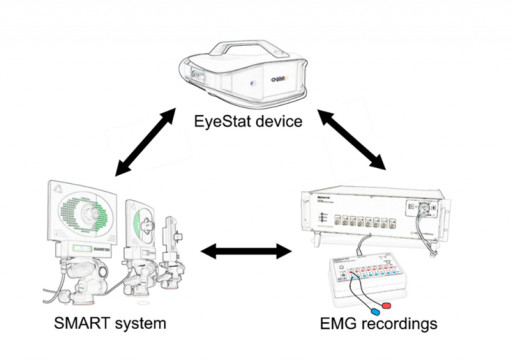Mental Health Conditions a Psychiatrist Can Address
AUSTIN, Texas, March 9, 2023 (Newswire.com)
–
iQuanti: Psychiatrists diagnose and treat mental health conditions. A psychiatrist can address a range of issues…
Penguin Random House & PBS KIDS’s 5-Word Speech at the 23rd Annual Webby Awards
 Shannon Bishop Lynn Kestin Sessler Alison Folino Traci Lawson, Director of Content Executive Producers Producer at Penguin Random
Shannon Bishop Lynn Kestin Sessler Alison Folino Traci Lawson, Director of Content Executive Producers Producer at Penguin Random
An Independent Study Comparing Blink Reflex Detection Device EyeStat to Standard Lab Techniques Concludes That the Device Provides Reliable and Accurate Measures
 The research opens the doors for promising applications that can help people with neurological diseases such as Parkinson’s.
The research opens the doors for promising applications that can help people with neurological diseases such as Parkinson’s.
CHARLESTON, S.C., March 9, 2023 (Newswire.com)
–
An independent study titled “Validating a Portable Device for Blinking Analyses through Laboratory Neurophysiological Techniques,” carried out by prominent blink researcher Matteo Bologna, M.D., sheds light on technological solutions that can help millions of people with neurological diseases around the world. The study compared revolutionary blink reflex technology by blinkcns, Inc., called EyeStat, with standard lab techniques and concluded that the former provides reliable and accurate measures.
The technology is the brainchild of The Medical University of South Carolina (MUSC) and was licensed by blinkcns, a South Carolina-based biotech company that holds the worldwide rights to stimulating and analyzing the blink reflex to help improve the detection and management of neurological disease and conditions like Parkinson’s, ADHD, and TBI.
Their FDA-cleared technology, EyeStat, uses 8 light puffs of air to stimulate a patient’s blink reflex in a 30-second test. The technology can also be configured to measure a patient’s spontaneous or voluntary blink, requiring no stimulus. The system employs high-speed videography to capture and record the eyelids and measure various parameters of the blink reflex using a proprietary algorithm.
In the study, Dr. Bologna recorded eye-blink kinematics using traditional laboratory-based techniques and compared it with the data obtained from the portable EyeStat device. To conduct the analysis, sixteen healthy adults underwent spontaneous and voluntary blink recordings and used the SMART motion analysis system and EyeStat device. The recorded blinking data showed a linear relationship with the outcome collected with the SMART system (p ranged from
These outcomes showed high reliability and accuracy of a blinking analysis compared to traditional processes. The study concluded that EyeStat, due to its portable nature and underlying technology, makes recording blinking more accessible in daily clinical practice and research activities. This would allow for future large-scale studies with patients with neurological diseases and healthy subjects in diverse clinic settings. During the experimentation session, none of the participants experienced any adverse effects.
Referring to the study, blinkcns CEO Ryan Fiorini said, “The eyes are the window into the brain. The blink reflex, specifically, can tell a whole story about what’s going on in the brain neurologically. We want to thank Dr. Bologna for the invaluable independent research that will undoubtedly shed light on the scientific advantages of using this technology to assess the blink reflex. We hope it will go a long way to helping people across the globe in various clinical settings.”
Using the portable device, data can easily be obtained in patients with neurological conditions or neurodegenerative diseases, specifically ADHD, TBI, and Parkinson’s, blinkcns’ main research areas. Another application is to generate valuable data to monitor the short to long-term effects of surgery and drugs.
People interested in reading the insightful scientific publication about blink reflex can visit the following link: https://www.mdpi.com/2076-3425/12/9/1228/html.
About blinkcns: Blinkcns (formerly blinktbi) is a Charleston, SC-based biotech company dedicated to improving the detection and management of neurological disease through rapid, non-invasive collection of objective data from the eyes. The company holds the world-wide rights to stimulating and analyzing the blink reflex by the means of air, sound or light. Their FDA-cleared technology, called EyeStat, measures the blink with gentle air puffs to provide objective data about the brain. With foundational research in traumatic brain injury (TBI), the company is exploring clinical programs in other neurological disease states and conditions such as Parkinson’s, ADHD, Dry Eye, and more.
Contact Information:
Jackie McKelvey
Chief Operating Officer
9083300802
Prolocor Announces Appointment of Edward L. Rosen to Its Board of Directors
 Prolocor Logo Prolocor Logo
Prolocor Logo Prolocor Logo
PHILADELPHIA, March 9, 2023 (Newswire.com)
–
Prolocor, Inc., a healthcare startup developing an innovative precision diagn…
10 Questions Psychiatrists Might Ask to Check on Your Progress
AUSTIN, Texas, March 9, 2023 (Newswire.com)
–
iQuanti: If you’re starting a new treatment plan, you’ll likely have several follow-up appointments with your ps…
AGFA HealthCare Demonstrates How Its Pioneering Enterprise Imaging Technology Revolutionizes the Way Distributed Health Networks Manage Medical Imaging
 At HIMSS23, Chicago, AGFA HealthCare, the Enterprise Imaging pioneer and innovator, will showcase how its latest generation of the Enterprise Imaging platform (AGFA EI) supports health systems’ goals to deliver sustainable and superior care outcomes, across local community networks or geographically distributed organizations.
At HIMSS23, Chicago, AGFA HealthCare, the Enterprise Imaging pioneer and innovator, will showcase how its latest generation of the Enterprise Imaging platform (AGFA EI) supports health systems’ goals to deliver sustainable and superior care outcomes, across local community networks or geographically distributed organizations.

AGFA HealthCare at HIMSS23
AGFA HealthCare – Introducing the Imaging Health Network\u2122 at HIMSS23
GREENVILLE, S.C., March 9, 2023 (Newswire.com)
–
Introducing the Imaging Health Network™ – AGFA HealthCare introduced the single-source-of-truth Imaging Health Record™ (IHR) to empower clinicians with frictionless access to imaging information, so they can find their flow and stay focused on patients. The Imaging Health Network™ (IHN) further advances seamless access to patient imaging across high-volume health networks and affiliates.
The Imaging Health Network™ is an aggregated community health record for medical imaging, in which all contributing providers publish their portion of the patient’s journey. At each step along this journey, the patient is assured that the physician has access to the entire cross-provider imaging record. With the IHN in place, care providers can save, view, and access patient imaging information in real time, supporting clinical history confidence.
The latest generation AGFA HealthCare Enterprise Imaging breaks the old paradigm of routing data to the user and instead brings the ‘user to the data’ via real-time streaming technology.
Mark Burgess, President, North America, AGFA HealthCare, explains: “Our vision for Enterprise Imaging is to act at the intersection of patient care and technology. We believe that clinicians deserve a ‘Life in flow,’ that enables them to stay focused on the task at hand, without the unnecessary distractions that old-school imaging systems create. The AGFA EI Imaging Health Network™ creates an extended community of shared patient imaging to advance sustainable care. AGFA EI is the backbone that health systems can build upon as they adopt the benefits of the Imaging Health Record™, for all medical specialties that generate or consume imaging.”
HIMSS23 attendees are invited to experience Enterprise Imaging Innovations
At AGFA HealthCare’s booth, participants can discover how AGFA EI keeps the entire healthcare ecosystem in flow: from IT specialists to multi-service line clinicians, management, and patients. The result is the ability to leverage medical imaging across the care continuum, empowering the delivery of exceptional patient care.
Increase radiology and cardiology efficiency by creating a fair work distribution. Share workloads enterprise-wide with AGFA HealthCare workflow orchestration and the Shared Reading Workflow. Clinicians can spend less time on low-impact tasks, and more time on high-impact work.
Augment decision-making, and support clinical accuracy and fast diagnosis with the RUBEE® for AI solution. Enable speedy care and access to patient data – no matter the modality, no matter the place, with AGFA HealthCare Enterprise Imaging POCUS.
Improve the cardiologist’s work experience with Enterprise Imaging for Cardiology, across specialties and modalities, while offering web-based image viewing and access.
Increase your image storage and viewing, data security, scalability and accessibility while controlling costs, with AGFA HealthCare’s modular approach to Cloud Solutions.
Dan Brown, Chief Technology Officer, AGFA HealthCare adds: “With a single, clinical database platform, we can enable a leaner organization that supports each and every person in the health system to be the best version of themselves. Fewer IT systems means less resources and time are required for management, while fewer applications reduces the requirements for servers, storage and infrastructure support. Our pioneering technology provides a true ‘less is more’ approach, delivering what health systems are demanding in order to operate successfully in today’s challenging care and financial environment.”
“That’s life in flow” – AGFA HealthCare delivers ‘Life in flow’ to meet radiologists’, as well as all clinicians’, daily challenges by means of a highly focused and customizable experience. Through automation, straightforward integration, and cross-team collaboration, our Imaging Health Record™ gives clinicians a truly comprehensive view of their patients, letting them spend less time searching for data – and more time focused on helping people.
To find your flow, find our booth: AGFA HealthCare booth #1902, HIMSS23, Chicago, or contact us for a special discussion at your convenience. Also, please stop by for our Belgian Beer Tasting, Tuesday, April 18, and Wednesday, April 19, beginning at 4:00 PM.
Contact Information:
Miriam Ladin
Marketing and Communication Americas
+1 978 284 7777
Original Source:
AGFA HealthCare Demonstrates How Its Pioneering Enterprise Imaging Technology Revolutionizes the Way Distributed Health Networks Manage Medical Imaging
Legacy Suite Announces Publication of Patent for Management of Digital and Traditional Assets
 Developers of estate planning, password manager, and crypto wallet solutions announce the publication of a U.S. patent.
Developers of estate planning, password manager, and crypto wallet solutions announce the publication of a U.S. patent.
…
Prada | Fall Winter 2023/2024 | Menswear
 Prada | Fall Winter 2023/2024 by Miuccia Prada and Raf Simons | Full Fashion Show in High Definition.
Prada | Fall Winter 2023/2024 by Miuccia Prada and Raf Simons | Full Fashion Show in High Definition.
Speech To Change Your Life Today! Admiral McRaven “Make Your Bed” Motivational Words Of Wisdom
 University of Texas at Austin 2014 Commencement Address Speech By Admiral McRaven Leaves The Audience Speechless With Great
University of Texas at Austin 2014 Commencement Address Speech By Admiral McRaven Leaves The Audience Speechless With Great
Emergency Medical Services Near Disney World
ORLANDO, Fla., March 8, 2023 (Newswire.com)
–
iQuanti: It’s no stretch to say that amusement parks are their own world. Their visitors often enjoy larger-than…
